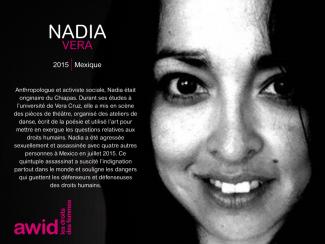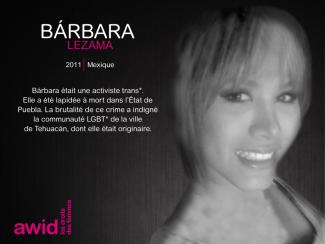
Barbara Lezama

El Consejo de Derechos Humanos (CDH) es el cuerpo intergubernamental del sistema de las Naciones Unidas responsable de la promoción y protección de todos los derechos humanos en todo el mundo. El HRC se reúne en sesión ordinaria tres veces al año, en marzo, junio y septiembre. La La Oficina del Alto Comisionado para los Derechos Humanos (ACNUDH) es la secretaría del Consejo de Derechos Humanos.
Debate y aprueba resoluciones sobre cuestiones mundiales de derechos humanos y el estado de los derechos humanos en determinados países
Examina las denuncias de víctimas de violaciones a los derechos humanos o las de organizaciones activistas, quienes interponen estas denuncias representando a lxs víctimas.
Nombra a expertos independientes que ejecutarán los «Procedimientos Especiales» revisando y presentado informes sobre las violaciones a los derechos humanos desde una perspectiva temática o en relación a un país específico
Participa en discusiones con expertos y gobiernos respecto a cuestiones de derechos humanos.
A través del Examen Periódico Universal, cada cuatro años y medio, se evalúan los expedientes de derechos humanos de todos los Estados Miembro de las Naciones Unidas
Se está llevarando a cabo en Ginebra, Suiza del 30 de junio al 17 de julio de 2020.
AWID trabaja con socios feministas, progresistas y de derechos humanos para compartir conocimientos clave, convocar diálogos y eventos de la sociedad civil, e influir en las negociaciones y los resultados de la sesión.
par Nandini Tanya Lallmon
Olajumoke « Jay » Abdullahi et Kym Oliver sont des féministes révolutionnaires à plus d'un titre. (...)
illustration : « Éclose » de Titash Sen >

✉️ Inscripción presencial cerrada. Regístrate para la transmisión en vivo aquí
Evento en inglés
📅 Miércoles 12 de marzo de 2025
🕒 De 12:00 a 01:30 pm, EST
🏢 PNUD, 304 E 45th St. Doha Room, 11th Floor (FF Building)
Organizan: PNUD, Femena, SRI y AWID
Fadila M. était une activiste “tribale” Soulaliyate d’Azrou, dans la province marocaine d’Ifrane. Elle s'est battue contre une forme spécifique de discrimination à l'égard des femmes “tribales” liée à la propriété foncière.
Dans le cadre du Mouvement en faveur des droits fonciers des femmes Soulaliyates, elle a travaillé pour la révision de la législation-cadre relative à la gestion des biens communautaires, avec l'adoption en 2019 de trois projets de lois garantissant l'égalité des femmes et des hommes.
Selon le droit coutumier en vigueur, les femmes n'avaient pas le droit de bénéficier de la terre, surtout celles qui étaient célibataires, veuves ou divorcées. Au Maroc, les droits à la terre collective se transmettaient traditionnellement entre les membres masculins de plus de 16 ans issus d’une même famille. Depuis 2007, Fadila M. faisait partie du mouvement des femmes, à savoir la première mobilisation populaire nationale de revendication de leurs droits fonciers. Parmi leurs victoires, citons le fait qu'en 2012, les femmes Soulaliyates ont pu, pour la première fois, s'inscrire sur les listes de bénéficiaires et disposer d'une indemnisation liée à la cession des terres. Le mouvement a également réussi à faire modifier le dahir de 1919 (décret du roi du Maroc) de façon à garantir aux femmes le droit à l'égalité.
Fadila M. s’est éteinte le 27 septembre 2018. Les circonstances de sa mort, survenue alors qu’elle participait à une marche de protestation sur la question des terres collectives, ne sont pas claires. Si les autorités déclarent que sa mort est accidentelle et qu'elle a fait un arrêt cardiaque sur le chemin de l'hôpital, la section locale de l'Association marocaine des droits de l'homme (AMDH), affirme quant à elle que Fadila a été étouffée par un membre des forces policières arborant un drapeau marocain. Sa famille a demandé qu’une enquête soit menée mais les résultats de l'autopsie n'ont pas été communiqués.
Apprenez-en davantage sur le Mouvement en faveur des droits fonciers des femmes Soulaliyates
Veuillez noter: Nous n'avons pu trouver aucune photo de Fadima M. C'est pourquoi cette illustration (au lieu d'un portrait) représente ce pour quoi elle s'est battue et a travaillé : la terre et le droit d'y vivre et d'avoir accès à cette terre et ce qui y pousse.
Alors que les fondamentalismes, les fascismes et autres systèmes d’oppression se métamorphosent et trouvent de nouvelles tactiques et stratégies pour consolider leur pouvoir et influence, les mouvements féministes persévèrent et célèbrent leurs victoires nationales, régionales et internationales.

La [MB1] reconnaissance en 2019 par le Conseil des droits de l’Homme du droit à l’intégrité et à l’autonomie corporelles, par exemple, a marqué une étape cruciale. Des résolutions du Conseil sur la discrimination envers les femmes et les filles admettent cependant un recul lié à des groupes de pression rétrogrades, des conceptions idéologiques ou un détournement de la culture ou la religion pour s’opposer à l’égalité de leurs droits. Des avancées féministes sont aussi notées dans le travail des Procédures spéciales, qui soulignent notamment l’obligation des États de contrer les doctrines de l’idéologie du genre, rappellent à l’ordre les antidroits qui détournent des références à la « culture », et signalent que les convictions religieuses ne peuvent pas servir à justifier la violence ou la discrimination.
Even in times of climate crisis, governments continue to encourage large-scale agriculture industries to expand. These activities poison the land, threaten biodiversity, and destroy local food production and livelihoods. Meanwhile, while women produce the majority of our food in the world, they own almost none of the land.
What if we perceived land and Nature not as private property to exploit, but as a whole to live in, learn from, and harmoniously coexist with? What if we repaired our relationships with the land and embraced more sustainable alternatives that nurture both the planet and its communities?
Nous Sommes la Solution (We Are the Solution, NSS) is one of many women-led movements striving to do this. This is their story.
by Alejandra Laprea
I live in a country of the impossible, where there are no bombs yet we are living in a war. (...)
artwork: “Entretejidas” [Interwoven women] by Surmercé >
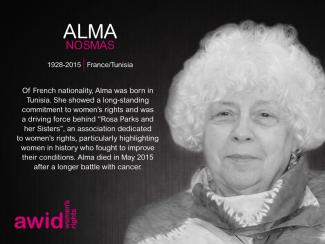
“I didn’t plan to be a singer, singing planned to be in me.” - Dorothy Masuka (interview with Mail & Guardian)
One such song titled “Dr. Malan” (named after the pro-apartheid politician D.F. Malan) was banned. She went on to record “Lumumba” (1961), a song about the assassination of the anti-colonial leader Patrice Lumumba. Dorothy’s work and activism attracted the attention of the Special Branch of the South African police and she was forced into a political exile that would span over three decades. Throughout this time, she worked with pro-independence groups including the African National Congress. In 1992, as apartheid started to crumble and Nelson Mandela was released from prison, she returned to South Africa.
Some of her other work includes the first song she recorded in 1953 entitled “Hamba Notsokolo”, a hit in the 1950s and a valued classic. She also wrote “El Yow Phata Phata”, a song that was adapted by Miriam Makeba, making “Pata, Pata” popular internationally.
Rooted in resistance, Dorothy’s music and activism were intertwined, leaving a magnificent and inspiring legacy. She was also widely known as “Auntie Dot”.
On 23 February 2019 at the age of 83, Dorothy passed away in Johannesburg due to ill health.
Watch Dorothy Masuka in an interview with Mail & Guardian
Listen to some of her music:
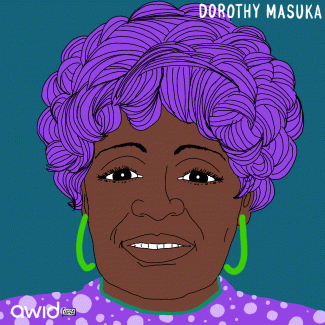
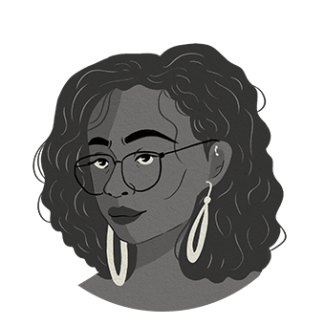 |
Akosua Hanson est une activiste artistique, basée à Accra, au Ghana. Son travail se répartit entre la radio, la télévision, la presse écrite, le théâtre, le cinéma, les expositions de bandes dessinées, les installations artistiques et le roman graphique. L’activisme d’Akosua se concentre sur le panafricanisme et le féminisme et s’intéresse particulièrement au point d’intersection entre l’art, la culture pop et l’activisme. Elle a une maîtrise de philosophie en études africaines axée sur le genre et la pensée philosophique africaine. Akosua Hanson est la créatrice de Moongirls, une série de romans graphiques qui suit les aventures de quatre super-héroïnes luttant pour une Afrique libérée de la corruption, du néocolonialisme, des fondamentalismes religieux, de la culture du viol, de l’homophobie, entre bien d’autres choses. Elle travaille comme animatrice radio à Y 107.9 FM, au Ghana. |
Dans ces panneaux, la Moongirl (fille de la lune) Wadjet est en train de faire l’amour BDSM avec un démon de deux genres. Parmi les quatre Moongirls, Wadjet est la guérisseuse et la philosophe la conduit vers l’Oracle. Elle fait cela pour lancer un processus scientifique et spirituel – une expérience qu’elle appelle « Illumination par la lumière de la pleine lune » – à travers laquelle elle trace un arc temporel vibratoire entre ses souvenirs, ses sensations, ses émotions, ses visions et son imagination. C’est une forme de voyage sensationnel dans le temps pour découvrir ce qu’elle appelle « des révélations de vérité ».
Au cours de l’expérience, Wadjet a des visions troubles, entre autres sur : une apocalypse imminente provoquée par la destruction de l’environnement par les humains au service d’un capitalisme vorace; un souvenir d’enfance sur son hospitalisation après un diagnostic de santé mentale; et une vision de l’histoire d’origine des Moongirls par la figure biblique de Noé présentée comme une ancienne Moongirl noire avertissant des dangers de la pollution de l’environnement.
Plus qu’une entorse amusante pour explorer des sensations, le BDSM peut être un moyen d’aborder la douleur émotionnelle et les traumatismes. Cela a été pour moi un moyen de guérison sexuelle, offrant une forme radicale de libération. Une purge survient lorsque la douleur physique est infligée au corps. Infligée avec consentement, elle fait ressortir la douleur émotionnelle - presque comme un « appel ». Le fouet sur mon corps me permet de libérer des émotions refoulées : l’anxiété, la dépression, mon sentiment d’impuissance face aux stress qui me submergent parfois.
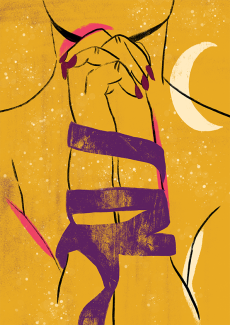
En s’engageant dans le BDSM comme moyen de guérison, les amoureux·ses doivent apprendre à faire preuve d’attention et de responsabilité envers l’autre. Car même si le consentement a été initialement donné, nous devons demeurer aux aguets face aux changements qui pourraient survenir durant le processus, notamment à mesure que les sentiments s’intensifient. J’aborde le BDSM avec la compréhension que pour abandonner la douleur, l’amour et l’empathie doivent être la base du processus, et ainsi, je crée un espace où je m’ouvre à l’amour.
L’implication avec suivi après l’infliction de la douleur vient compléter le processus. Cela peut se faire de manière très simple, en se faisant des caresses, en vérifiant si la personne a besoin d’eau, en regardant un film ensemble, en se prenant dans les bras ou simplement en partageant un joint. Cela peut se faire par n’importe quel langage amoureux que l’on a choisi. Cet espace de soutien, sachant que les plaies ont été ouvertes, est nécessaire pour achever le processus de guérison. C’est la plus importantes des leçons pour mettre en pratique l’empathie, ainsi qu’un apprentissage pour vraiment soutenir son·sa partenaire, notamment en raison de la finesse des lignes entre la douleur et le plaisir. De cette façon, le BDSM est une forme de travail de soins pour moi.
Après le sexe BDSM, je ressens une clarté et un calme qui me placent dans un vaste espace créatif et qui me renforcent sur le plan spirituel. C’est une expérience presque magique de voir la douleur se transformer en quelque chose d’autre instantanément. De même, cette expérience personnelle libératrice du BDSM permet à Wadjet d’accéder à la prescience, à la sagesse et à la clarté, l’aidant dans ses fonctions de Moongirl à lutter contre le patriarcat africain.
Moongirls est née durant mon mandat de directrice de Drama Queens, une jeune organisation militante artistique basée au Ghana. Depuis notre création en 2016, nous avons eu recours à différents modes artistiques dans le cadre de notre activisme féministe, panafricaniste et écologiste. Nous avons utilisé la poésie, les nouvelles, le théâtre, les films et la musique pour traiter de problèmes comme la corruption, le patriarcat, la dégradation de l’environnement et l’homophobie.
Notre production théâtrale inaugurale, « The Seamstress of St. Francis Street » (La couturière de la rue Saint-François) et « Until Someone Wakes Up » (Jusqu’à ce que quelqu’un·e se réveille), abordait le problème de la culture du viol dans nos communautés. De son côté, « Just Like us » (Tout comme nous), a sans doute été l’une des premières productions théâtrales ghanéennes à aborder directement le problème profondément ancré de l’homophobie dans le pays. Notre atelier de cinéma queer pour les cinéastes africains, Queer Universities Ghana (Universités queer Ghana), a formé des cinéastes du Ghana, du Nigéria, d’Afrique du Sud et d’Ouganda. Des films sont nés pendant cet atelier, comme « Baby Girl: An Intersex Story » (Bébé fille : une histoire intersexe) de Selassie Djamey, et ont continué à être projetés durant des festivals de cinéma. Ainsi, le passage aux bandes dessinées fut une évolution naturelle.
Il y a environ sept ans, j’ai commencé un roman, que je n’ai jamais terminé, sur la vie de quatre femmes. En 2018, l’Open Society Initiative for West Africa (OSIWA, Initiative de société ouverte pour l’Afrique de l’Ouest) a initié une opportunité de subvention, laquelle a lancé la production du projet et mon roman inachevé est devenu Moongirls.
Il y a eu deux saisons de Moongirls, comprenant chacune six chapitres. Les auteur·e·s et éditeurs·rices contribuant à la première saison étaient Suhaida Dramani, Tsiddi Can-Tamakloe, George Hanson et Wanlov the Kubolor. Les auteur·e·s de la deuxième saison comprenaient Yaba Armah, Nadia Ahidjo et moi-même. Les illustrations et conceptualisations des personnages ont été réalisées par l’artiste ghanéenne Kissiwa. Et AnimaxFYB Studio, un studio premium d’animation, de conception et d’effets visuels, a réalisé les illustrations.
|
|
L’écriture de Moongirls entre 2018 et 2022 a été pour moi un travail d’amour, voire un travail de libération. Je cherche à faire preuve de beaucoup d’exploration dans la forme et le style : j’ai essayé de convertir d’autres formes d’écriture, telles que des nouvelles et de la poésie, en format bande dessinée. En fusionnant illustration et texte, comme le font les bandes dessinées, Moongirls vise à s’attaquer aux grands problèmes et à honorer les activistes de la vie réelle. Ma décision de mettre au centre des super-héroïnes queer – ce qui est rare à voir dans ce canon – a pris une signification bien plus importante lorsqu’un contexte dangereux a commencé à se développer au Ghana en 2021.
L’année dernière a été le témoin d’une augmentation très claire des violences contre la communauté LGBT+ ghanéenne, déclenchée par la fermeture d’un centre communautaire LGBT+. S’en sont suivies des arrestations arbitraires et l’emprisonnement de personnes soupçonnées d’appartenir au spectre queer, ainsi que de personnes accusées de promouvoir un « agenda LGBT ». Pour couronner le tout, un projet de loi anti-LGBT intitulé « Droits sexuels humains appropriés et valeurs familiales ghanéennes » fut introduit au Parlement ghanéen. C’est sans doute le projet de loi anti-LGBT le plus draconien jamais rédigé dans la région, après des tentatives précédentes dans des pays comme le Nigeria, l’Ouganda et le Kenya.
Je me souviens très bien de la première fois où j’ai lu ce projet de loi.
C’était un vendredi soir, un soir où d’habitude je me repose ou je fais la fête après une longue semaine de travail. Par pure chance, le projet a été divulgué et partagé avec moi sur un groupe WhatsApp. En le lisant, un profond sentiment de peur et d’alerte venait plomber l’ambiance du vendredi soir ordinairement détendu. Ce projet de loi proposait de frapper tout plaidoyer LGBT+ de cinq à dix ans d’emprisonnement, de sanctionner et d’emprisonner les personnes qui s’identifient comme LGBT+, sauf si elles se « rétractaient » et qu’elles acceptaient une thérapie de conversion. Ce projet de loi criminalisait même les personnes asexuées. Il touchait à toutes les libertés fondamentales : la liberté de pensée, d’être, la liberté de détenir sa propre vérité et de choisir de vivre sa vie en fonction. Le projet touchait même aux réseaux sociaux et à l’art. S’il passait, Moongirls aurait été une littérature interdite. Ce que le projet de loi proposait de faire était si néfaste et si large que j’ai chuté dans une dépression à la profondeur de la haine à partir de laquelle il avait été conçu.
En parcourant mon fil Twitter de cette nuit-là, on voit bien la terreur que je ressentais en moi. Le fil était un flux d’émotions en direct alors que les gens réagissaient en temps réel à ce qu’ils lisaient : de la stupéfaction à la terreur en passant par une profonde déception et de la peine en réalisant à quel point le projet de loi voulait aller loin. Certain·e·s ont tweeté être prêt·e à se replier et à quitter le pays. Ensuite, à la manière ghanéenne, le chagrin et la peur se sont transformés en humour. De l’humour est né le zeste d’élever le combat.
Ainsi, le travail continue toujours. J’ai créé Moongirls pour fournir une forme alternative d’éducation, pour fournir des connaissances là où elles ont été supprimées par un patriarcat violent et pour créer de la visibilité là où la communauté LGBT+ a été effacée. Il est également important que le BDSM africain utilise ce support de représentation alors qu’une grande partie de la représentation BDSM est blanche. Le plaisir sexuel, par le biais du BDSM ou autre, ainsi que l’amour non hétérosexuel transcendent les races et les continents, car le plaisir sexuel et sa diversité d’expériences sont aussi vielles que le temps.
por Sophia Armen
Guste o no, lxs férrexs ungerhouis han sido parte esencial de nuestras historias de resistencia y están aquí para quedarse. (...)
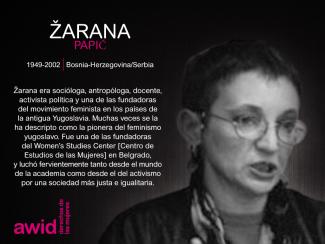
If the positions advertised have closed, or just don’t match your area of interest and expertise, we suggest the following resources for your job search.
El hogar de Esther Mwikali estaba en la aldea de Mithini, en el condado de Murang'a, Kenya. Esther fue una defensora del derecho a la tierra destacada y valorada que investigó los abusos contra okupas de tierras reclamadas por magnates. La investigación de la que participó Esther incluyó también violaciones del derecho a la tierra cometidas por personas con poder en Makuyu.
Luego de que Esther faltara a una de las reuniones de la aldea, un grupo de búsqueda salió a rastrear a Esther. El 27 de agosto de 2019, dos días después de su desaparición, el cuerpo de Esther fue encontrado en una granja cerca de su casa, con signos de tortura. Esther había sido brutalmente asesinada.
"El trabajo de Esther por evitar el desalojo de lxs integrantes de las comunidades de las tierras reclamadas por magnates era conocido por todxs. Para lxs activistas locales no existía ninguna duda de que su asesinato estaba relacionado con las luchas en la zona por el acceso a la tierra; un trágico recordatorio de la alarmante frecuencia con que se llevan a cabo las ejecuciones extrajudiciales en Kenia."- Global Wittness Report, Julio 2020
"Asociamos la muerte de Mwikali con las luchas locales por el derecho a la tierra, y exigimos al Gobierno que investigue el asunto sin demora." - James Mburu, portavoz de lxs okupas.
"Es necesario tomar medidas con respecto a las personas que presuntamente han amenazado a lxs ocupantes ilegales, incluida la familia de Mwikali". - Alice Karanja, Coalición Nacional de Defensorxs de Derechos Humanos
"El impacto de su trabajo y su tenacidad permanecerán vivos en Kenia durante décadas. El CJGEA consuela a las personas afligidas y pide justicia". - Comunicado de prensa del Centro para la Justicia y la Acción Gubernamental (CJGEA, por sus siglas en inglés), 13 de septiembre de 2019
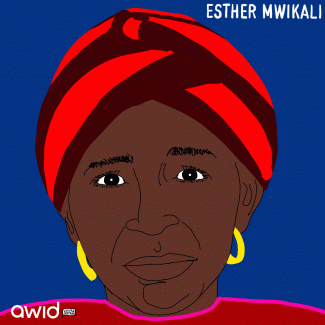
Merci, Ángela et Pilar
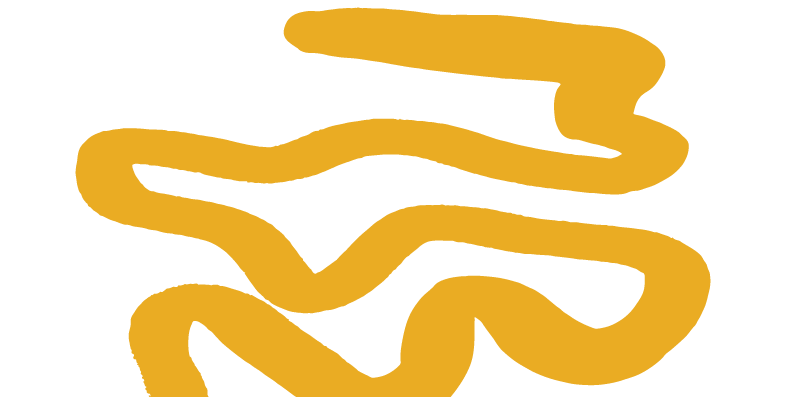
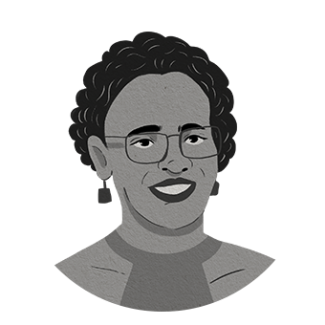 |
Yannia Sofía Garzón Valencia: Je suis une femme noire et une tisserande communautaire. Je vis à Santander de Quilichao dans le Cauca, en Colombie. Je m’intéresse aux processus créatifs autour desquels s’organise une vie collective durable. J’aime échanger des idées et cuisiner, faire des recherches et analyser, planter des graines et apprendre des plantes, lire et jouer. Je coordonne actuellement l’Observatoire des violences fondées sur le genre à l’encontre des communautés afro-descendantes en Colombie (@VigiaAfro). |
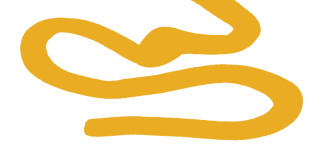
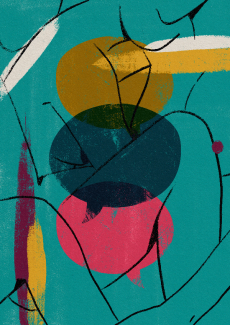
Il y avait une aire de jeux verte particulièrement grande, et nous étions assises sur de petits tabourets de bois sous un grand sureau. Nous faisions enfin l’expérience de cette autre forme d’amour – ce plaisir d’être ensemble et de s’écouter les unes les autres. Pour moi, ce genre de discussion compte parmi les expressions d’amour dont la vie me permettait de profiter depuis peu. Je ne savais pas que cette autre forme d’amour – que l’on trouve en dehors d’ateliers de formation, d’espaces d’activisme, de classes ou de lieux de travail – était possible. Mais nous trois, amies, avons passé l’après-midi entre nous, sans prétendre ne pas remarquer nos couleurs de peau respectives. C’était, au contraire, un facteur vécu qui nous permit de discuter de manière très intime des similitudes et des différences de nos expériences d’enfance et de jeunesse.
Ces discussions n’avaient aucun lien avec les prochaines activités du mouvement noir en Colombie, mais elles m’ont néanmoins nourrie et ont acquis de nouvelles significations. Notre intimité découlait de notre rapprochement, notre reconnaissance mutuelle et la perception de nos libérations uniques et individuelles. Et par la prise de conscience qu’il n’y a pas une, mais bien plusieurs voies vers la libération – ces voies que nous incarnions chaque fois que nous disions « non » et nous nous rebellions. Loin de tout malaise, nous nous sommes rencontrées avec une réelle authenticité empreinte de faiblesse et de force, qui nous rapprochait plus qu’elle ne nous séparait.
Notre objectif en ce bel après-midi était simplement d’être – d’avoir la conscience d’être simplement entre nous. Nous avons cheminé dans nos passés afin que nos mémoires conservées soient celles que nous avions décidé de garder en nous, et non celles que la peur avait fait entrer et inscrites en nous. Nous nous sommes remémoré des extraits très précis d’émissions de télé et avons chanté des chansons d’artistes qui nous avaient appris à bien aimer, à bien haïr, à jurer comme les pires brigands et à souffrir comme de vraies dames.
Nous nous sommes raconté nos mauvais coups à l’école, et ce qui demeurait dans notre subconscient d’avoir été exposées aux nombreuses manières qu’ont les médias de répéter la même chose – et après que les enseignantes et les nonnes à l’école nous aient abreuvées d’histoires nous incitant à nous identifier et à nous approprier les aspirations de Cendrillon pour nos propres vies. Cela donnait le ton pour le reste de notre histoire : le drame de la fille pauvre et affaiblie qui ne s’accomplira entièrement que par un acte qui la sauvera de sa condition. Et cet acte ne pourra que prendre la forme du regard d’un homme qui est, au minimum, blanc, méritant ainsi ce qui est entre nos cuisses – sa « principale aspiration » – et « la réalisation parfaite de nos rêves », ce qui nous était alors enseigné comme étant notre principale aspiration à nous aussi.
Nous étions trois, cet après-midi-là. Nous avions chacune été élevée dans une région différente du pays, mais il était absolument fascinant de néanmoins pouvoir citer des extraits de chansons et des situations de séries télévisées, qui – comme nous l’avons compris en apprenant à nous connaître – partageaient des codes ou des symboles répétés, à quelques différences près, dans nos maisons, dans nos premières relations et dans nos quartiers et nos écoles. Élevées par des « drames » (n’est-ce pas ainsi que l’on appelle ce genre si populaire?) dans lesquels plus on souffre plus on est méritante, la question de « comment et dans quelles situations est-il acceptable ou légitime de souffrir » devient un étalon important de la manière dont la personne qui souffre devrait être considérée, ce qu’elle devrait faire et qui elle devrait être. Certaines d’entre nous étions parvenues à nous libérer et à « apprendre » une définition de l’amour qui ne pouvait être apprise qu’à l’âge adulte, brisant toute illusion et acceptant le péché naturel. Et prenant conscience de la production industrielle d’une vierge, à qui nous pouvions refuser de ressembler car elle n’avait pas sa place dans notre entendement, et de la déception qu’apporte cette aliénation.
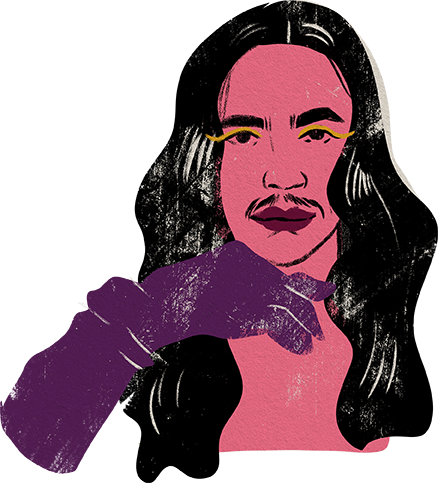
Après avoir chanté, nous avons examiné nos premières explorations sexuelles. Je n’avais jamais pensé que la plupart des gens en faisaient l’expérience avant l’âge de neuf ans et que, même à l’âge adulte, ces expériences et ces mémoires demeurent un fardeau encombrant. Même aujourd’hui, dans des milliers d’endroits, des millions de filles et de garçons voient leur innocence mise à mal par un manque de confiance et l’ignorance que nous affichons lorsqu’elles et ils tentent d’explorer leur corps. Blâmer la curiosité est un mécanisme de contrôle radicalement efficace. Nous sommes revenues sur les brèves conversations que nous avions eues lorsque nous avons changé l’histoire de nos vies, passant de Noires maudites à une perspective qui nous a permis de renaître. Nous avons évoqué le souvenir du nombre conséquent de tantes et de cousines qui avaient quitté leur maison, leur centre, leurs racines, à la recherche d’un avenir à l’extérieur, ailleurs.
« Elle apprit qu’il fallait qu’elle prenne soin de son ventre en gardant ses tissus au chaud, pour éviter le froid qui entre par cette partie plus souple sur le dessus de la tête, par les pieds, par les oreilles, afin de ne pas avoir mal, et particulièrement lorsque l’on a ses règles. Pour ce faire, il faut prêter attention à ce que l’on mange, à la manière dont on s’habille et à la manière dont on marche, car tout cela est en lien avec la santé des filles. »
L’avenir a un coût : il exige que les relations qui ont marqué notre enfance soient refaçonnées et jetées dans l’oubli. Ce sont nos fondations, mais elles ne sont pas pertinentes si nous voulons continuer à avancer. Pour nous, avancer était synonyme d’apprendre par cœur ce que nous nous faisions à nous-mêmes avec les occasions que nous trouvions ailleurs. Parce que c’est ailleurs, et non en nous, que se trouvent ces occasions, que nous sommes disponibles, que nous devons être à l’extérieur. Cependant, pour beaucoup de nos tantes et de nos cousines, le coût des rares occasions de s’inscrire et d’assister à des cours du soir ou de prendre un congé sabbatique du travail domestique était celui de devenir la première expérience sexuelle de proches qui vivaient dans l’avenir. Un avenir pour lequel d’autres avant elles avaient également payé, et dont elles avaient déjà oublié le prix. Cette exigence de paiement arrivait avec la même ponctualité que celle de la facture d’électricité. Nous n’accepterons pas cet héritage.
Il y avait, en Colombie et en Amérique latine, un manuel de bonnes manières intitulé La urbanidad de Carreño (Le manuel de bonnes manières de Carreño). Sa lecture était obligatoire dans les écoles publiques et privées jusque dans les années 1990. Ce manuel conditionnait la manière dont les corps étaient perçus et ma mère, accueillie et élevée par des nonnes carmélites, le connaissait par cœur. La première fois que je l’ai lu, j’ai dû m’arrêter à plusieurs reprises pour me frotter le ventre qui me faisait mal tant je riais. Il contient des instructions ridicules telles que : prenez une douche les yeux fermés et éteignez la lumière lorsque vous enfilez votre chemise de nuit. Différents chapitres traitent de la manière de se comporter à la maison, dans la rue, et lors d’un dîner ou d’un déjeuner public – soit les normes du bon goût et du savoir-vivre. La base éthique pour les bons citoyens était l’urbanité qui leur permettait de s’éloigner de la ruralité. Ce même manuel précisait que de saluer un proche de l’autre côté de la rue en criant n’était pas acceptable; les bonnes manières nous dictaient de traverser la rue. De la même manière, les hommes doivent retirer leur manteau et le mettre sur des flaques d’eau lorsqu’ils sont accompagnés par une femme, afin qu’elle ne mouille pas ses chaussures. Je pensais à la manière de saluer quelqu’un de l’autre côté d’une rivière, et au fait qu’il fait si chaud où nous vivons que nous ne portons pas de manteau.
L’auteur de ce manuel, Monsieur Carreño, est le contraire du grand-père d’une dame âgée née à Turbo. Elle me raconta un jour que son grand-père était un homme sage, qui lui avait parlé de l’accouchement et de la manière de prendre soin de son corps. Elle apprit qu’il fallait qu’elle prenne soin de son ventre en gardant ses tissus au chaud, pour éviter le froid qui entre par cette partie plus souple sur le dessus de la tête, par les pieds, par les oreilles, afin de ne pas avoir mal, et particulièrement lorsque l’on a ses règles. Pour ce faire, il faut prêter attention à ce que l’on mange, à la manière dont on s’habille et à la manière dont on marche, car tout cela est en lien avec la santé des filles. La femme âgée ajouta que son grand-père dévoué lui avait également enseigné que les crampes étaient plus fréquentes depuis que les sols des maisons n’étaient plus en terre battue ou en bois. Depuis le béton et le carrelage, ces matériaux qui permettaient au froid d’entrer dans la maison par les pieds, les tensions dans les tissus du ventre augmentaient également.
Encore une surprise. Il y avait une telle distance entre Don Carreño et le sage grand-père en termes de conscience de la vie – aussi grande que les injonctions à bien se comporter qui brident nos impulsions et nos sens, même le bon sens commun qui valorise la santé. C’est alors que je compris une des manières selon lesquelles le béton empêche la terre de respirer, et nous en empêche également par le fait même. Je n’avais pas réalisé qu’il y avait, et qu’il y a toujours, une architecture et des matériaux pour prendre soin de nos corps. En Colombie, et dans d’autres pays, les matériaux utilisés pour faire des maisons sont des indicateurs d’une pauvreté multidimensionnelle. Une maison construite avec du béton nous éloigne de la perception de la pauvreté. C’est là un simple exemple décevant de la manière dont le progrès nous incite à délaisser la relation entre notre environnement et notre corps. Le bon goût et l’urbanité nous poussent à l’extérieur : pour avancer, mentent-ils, il faut aller là-bas.
« Je compris une des manières selon lesquelles le béton empêche la terre de respirer, et nous en empêche également par le fait même. Je n’avais pas réalisé qu’il y avait, et qu’il y a toujours, une architecture et des matériaux pour prendre soin de nos corps. »
Nous étions embêtées par la prise de conscience que ni nos mères ni nos pères ne nous avaient parlé des menstruations, sauf quand la tache brune avait déjà sali nos culottes. Ils avaient échoué à nous protéger contre la honte qui était supposée être un sentiment naturel lorsque nos menstruations avaient commencé. Et avec les menstruations venaient les crampes souvent supportées en silence, parce qu’il y avait du travail à faire; certaines de ces crampes étaient dues à des kystes, des hématomes ou des fibromes qui avaient tué les grands-mères qui avaient découvert et oublié les traitements de soins, puis s’était oubliées elles-mêmes. L’haleine de nos mères et de nos pères devenait de plus en plus froide, mais l’Extérieur frigorifiait la familiarité et, au lieu de réchauffer nos ventres, exprimait des jugements avec des conseils qui semblaient être des avertissements à propos de la seule chose qui importe aux hommes. Ceci s’appliquait à tous les hommes – légitimant ainsi le rôle de pillage du phallus, comme si sa seule option était de prendre ce que nous avions entre nos cuisses. Les nombreuses versions de cette vérité étaient remplacées par une naturalisation inamovible et fortement ancrée : dire à toutes les femmes que nous devions nous préserver pour l’un d’entre eux, pour celui qui introduira le premier son pénis en nous, pour celui qui nous donnera quelque chose en échange, et que nous sommes des femmes uniquement car nous aspirons à, et nous le laissons le mettre en nous. Quand j’étais une petite fille, j’ai exploré des petits pénis et des petits clitoris et, entre les séances de jeux entre filles, la question chuchotée était : à qui le tour de jouer l’homme et à qui le tour de jouer la femme? Et la réponse : les débuts de petits orgasmes, peu importe avec qui. Je suppose que la même chose doit se passer entre les corps de garçons.
Les expériences et les explorations de nos tantes, nos cousines et nos proches portaient essentiellement sur le corps et sa nudité en tant que tabou. Elles évitaient de l’exprimer et de le nommer, au point de le couvrir, de donner de nouveaux noms à ses excrétions, ses expulsions, sa procréation et, juste entre nous les femmes, ses fonctions de réception. J’ai entendu un jour une femme âgée dans un atelier de formation dire que lorsqu’elle vivait avec sa grand-mère, son souvenir était que cette vieille femme dormait en gardant un œil ouvert, avec un fusil posé sur son matelas. Le bruit le plus ténu dans la nuit suffisait à ce qu’elle empoigne son arme et vise. C’est là une situation courante en Colombie Pacifique, où certains comportements très néfastes sont normalisés. Des hommes mariés ou célibataires qui aiment bien une jeune femme pénètrent dans sa chambre la nuit – on appelle ça la gateada. Et cela n’est pas sans risque : si les tenant·es de l’autorité dans la famille réalisent ce qu’il se passe, qu’il s’agisse d’un abus ou non, l’homme peut être blessé, voire tué.
Cette habitude de faire sa propre loi n’a cependant jamais mis un terme aux gateadas, même encore aujourd’hui. Lors de ce même atelier – comme je le répétais à mes sœurs – d’autres participantes dirent que ni elle ni leur mère ne laisserait leur fille seule avec leur père à l’heure du bain, à moins que les filles ne portent un sous-vêtement. Je me suis alors souvenue de la voix de mon père me disant, lorsque j’avais sept ans, ta mère ne m’a jamais laissé te donner le bain. Après avoir parlé de cela, une autre femme répondit que, au contraire, son père l’a baignée toute nue dans la cour de sa maison d’enfance jusqu’à ses sept ans, puis son frère aîné le fit jusqu’à ses neuf ans. Elle ne sentit jamais quoi que ce soit de bizarre à la manière dont ils la regardaient; pour eux, c’était là simplement une autre tâche consistant à prendre soin de l’enfant la plus gâtée de la maison. Elle se souvient avoir été vue pour ce qu’elle était : une enfant fille, une enfant sœur, qui n’aimait pas l’eau.
Les enfances, à nouveau, hier comme aujourd’hui. Nous avons été surprises par cette histoire qui nous a réconfortées. Même moi j’avais vu que les choses étaient différentes ailleurs; le père de ma fille lui a donné son bain dans la baignoire jusqu’à ce qu’elle soit âgée d’environ deux ans. Même avant ses deux ans, il lui donnait de légères tapes sur les fesses, vers le haut, pour les faire grossir, disait-il. Nous pourrions ici parler de dimensions supplémentaires de la manière dont nous construisons nos corps, mais c’est là une tout autre histoire. Pour moi, il s’agissait d’une tâche de soins, parmi les nombreuses autres, que nous avions décidé d’un commun accord de répartir entre nous, avant même la naissance du bébé. Et la décision de ne pas considérer chaque homme comme un violeur en embuscade ne signifie pas que ce ne sont pas des violeurs, mais plutôt qu’ils peuvent arrêter de l’être. Il y a également des hommes et des corps masculins qui ont été élevés à ne jamais être des violeurs.
Cela a toujours cours. C’est arrivé à une de nos amies et à ma propre fille. Je me suis dit : comment se fait-il que certaines femmes soient en couple avec des hommes à qui elles ne peuvent pas faire confiance pour prendre soin de leur fille? Je suis sûre que ma mère aimait mon père. Et, bien qu’on ne parle que rarement de la femme qu’elle était avant de devenir ma mère, je sais que ces expériences d’abus ne peuvent être comparées à la brutalité et à la tolérance exagérée envers celles d’aujourd’hui. Mais cela demeure une décision que de nombreuses femmes dans de nombreux lieux prennent, ce qui entraîne d’autres questions. À quelle fréquence, combien de fois, ont eu lieu les cas d’abus dans nos familles élargies pour que les femmes interdisent de manière ouverte, ou de manière imperceptible, à leurs partenaires de donner le bain à leur fille? Est-ce que cela est en lien avec la surexposition médiatique à laquelle nous sommes soumises et soumis dès notre naissance? Qu’est-ce qui délite les liens familiaux et les transforme en simples échanges de satisfaction corporelle? Est-ce que cela tient à la proximité des valeurs urbaines qui portent tant d’attention aux bonnes formes des corps des femmes en tant qu’objets de désir, et poussent les corps masculins à se comporter comme des propriétaires et des conquérants, remplissant la mission de mimétisme des représentations médiatiques pour être rassurés dans leur identité? Est-ce le béton et d’autres codes, comme les bonnes manières de Carreño, qui les font perdurer? Est-ce encouragé par le besoin d’oublier certaines relations comme prix du progrès, cette insistance à « faire pour l’extérieur »? Que se passe-t-il avec ce que nous avons appris à notre époque, celles et ceux qui, en secret ou non, se sont adonné·e·s à des explorations sexuelles en tant qu’enfants? Cela a-t-il été effacé par la culpabilité? S’agissait-il des graines de méfiance et de honte en nous-mêmes? En effet, ne s’agit-il pas là de possibilités d’apprentissage dans lesquelles avoir confiance, comprendre la nudité des corps comme faisant partie du respect de soi-même et des autres? Ces questions émergent dans des espaces de confiance, où la peur de dire ce que l’on pense et ce que l’on ressent est chassée par l’intention de l’accompagnement. J’imagine combien nous sommes, dans tous les coins de cette planète, et je suis certaine que ce ne sont pas de nouvelles questions, que les messages qu’elles contiennent sont répétés, et que l’on se trouve à vivre dans les réponses.

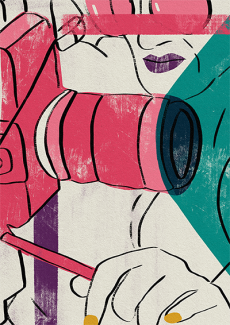
Cette édition du journal, en partenariat avec Kohl : a Journal for Body and Gender Research (Kohl : une revue pour la recherche sur le corps et le genre) explorera les solutions, propositions et réalités féministes afin de transformer notre monde actuel, nos corps et nos sexualités.

نصدر النسخة هذه من المجلة بالشراكة مع «كحل: مجلة لأبحاث الجسد والجندر»، وسنستكشف عبرها الحلول والاقتراحات وأنواع الواقع النسوية لتغيير عالمنا الحالي وكذلك أجسادنا وجنسانياتنا.
par Ana María Belique
El Batey Naranjo est une communauté un peu à l’écart de la ville mais regorgeant de personnes travailleuses et enthousiastes. (...)
< illustration : « Tejedoras de sueños » (« Tisseuses de rêves ») , par Diana Mar
